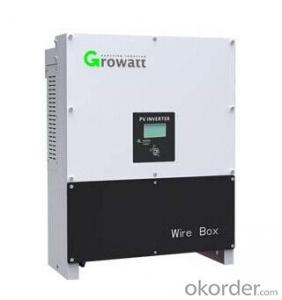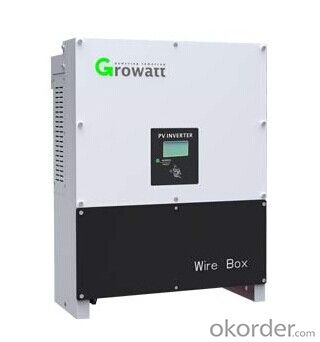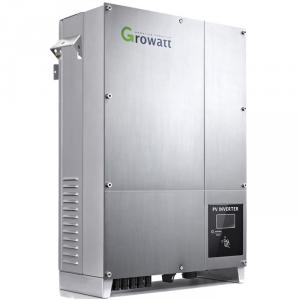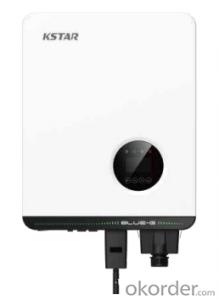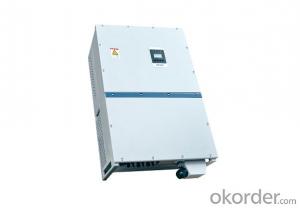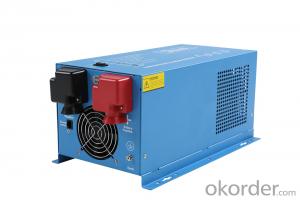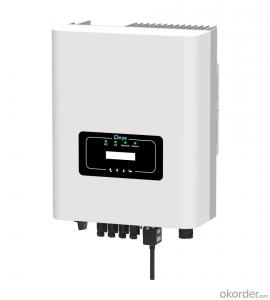Solar Inverter Battery String Solar Power Inverter 10KW-20KW-US, ETL
- Loading Port:
- Shekou
- Payment Terms:
- TT OR LC
- Min Order Qty:
- 5 watt
- Supply Capability:
- 10000 watt/month
OKorder Service Pledge
OKorder Financial Service
You Might Also Like
String Solar Power Inverter 10kw-20kw-US, ETL
Specifications
Maximum efficiency of 98%
Multi MPP controller
MTL String
Bluetooth technology&Sound controlPV Inverter 10000UE,12000UE,18000UE,20000UE-US Series
Leading - edge Technology
High efficiency of 97.5% delivery more energy
Dual independent MPP tracking lead to optimal energy harvesting
Integrated DC disconnect switch
Consistent and stable performance across entire input voltage and
output power range
True three-phase transformerless GT topology
Bluetooth / RF technology / Wi-Fi
Sound control, easy installation maintenance procedure
Newest generation IGBTs and advanced MPPT algorithms
Comprehensive protection for IGBTs, overvoltage, islanding,
short-circuit,overload,overheat,etc
Flexible system design with safety fuse module and lightening
proof moduleModel
Specification
10000TL3-US
12000TL-US
18000TL-US
20000TL-US
Input data(DC)
Max. recommended PV power
12500W
15000W
21600W
24000W
Max. DC Power
10500W
12500W
18750W
20850W
Max. DC voltage
600V
600V
600V
600V
Start voltage
120V
120V
120V
120V
DC nominal voltage
375V
375V
375V
375V
PV voltage range
80V-600V
80V-600V
80V-600V
80V-600V
MPP voltage range(Full load)
250V-600V
250V-600V
250V-600V
250V-600V
Max. input current of the MPP tracker A/tracker B
21A/21A
25A/25A
38A/38A
42A/42A
Max. input short circuit current
32A/32A
32A/32A
50A/50A
50A/50A
Number of independent MPP trackers/strings per MPP tracker
2/3
2/3
2/6
2/6
Output data(AC)
Nominal output power
10000W
12000W
18000W
20000W
Nominal AC voltage
480V
480V
480V
480V
AC voltage range
422-528VAC
422-528VAC
422-528VAC
422-528VAC
Nominal AC grid frequency
60 Hz
60 Hz
60 Hz
60 Hz
AC grid frequency range
59.3-60.5 Hz
59.3-60.5 Hz
59.3-60.5 Hz
59.3-60.5 Hz
Max. output current(cos φ=1)
12.0A
14.5A
21.5A
24A
Power factor(cos φ)
>0.99 (0.9 Leading to 0.9 Lagging)
>0.99 (0.9 Leading to 0.9 Lagging)
>0.99 (0.9 Leading to 0.9 Lagging)
>0.99 (0.9 Leading to 0.9 Lagging)
Harmonics
<3%< span="">
<3%< span="">
<3%< span="">
<3%< span="">
Grid connection type
3/N/E
3/N/E
3/N/E
3/N/E
Efficiency
Max. efficiency
97%
97%
97.5%
97.5%
CEC-Weighted efficiency
95.5%
95.5%
96%
96.5%
MPPT efficiency
99.5%
99.5%
99.5%
99.5%
Protection devices
DC reverse-polarity protection
yes
yes
yes
yes
Input over voltage protection -Varistor
yes
yes
yes
yes
DC switch for each MPP tracker
yes
yes
yes
yes
Input over voltage protection -DIN rail surge arrester(Option)
Class II
Class II
Class II
Class II
DC insulation measure
yes
yes
yes
yes
AC short circuit protection
yes
yes
yes
yes
Output over voltage protection -Varistor
yes
yes
yes
yes
Output over voltage protection -DIN rail surge arrester(Option)
Class II
Class II
Class II
Class II
String fuse type/size(Option)
15A/600VDC 10*38mm
15A/600VDC 10*38mm
15A/600VDC 10*38mm
15A/600VDC 10*38mm
General Data
Dimensions(W*H*D)
530*705*247mm 20.8/27.6/9.7inch
530*705*247mm 20.8/27.6/9.7inch
650*740*247mm 25.6/29.1/9.7inch
650*740*247mm 25.6/29.1/9.7inch
Weight
46kg/101.5lb
46kg/101.5lb
63kg/138.9lb
63kg/138.9lb
Operating ambient temperature range
–25°C ... +60°C –13°F ... +140°F (Derating above 40°C/104°F)
–25°C ... +60°C –13°F ... +140°F (Derating above 40°C/104°F)
–25°C ... +60°C –13°F ... +140°F (Derating above 40°C/104°F)
–25°C ... +60°C –13°F ... +140°F (Derating above 40°C/104°F)
Noise emission
≤50dB(A)
≤50dB(A)
≤50dB(A)
≤50dB(A)
Relative Humidity
0~95%
0~95%
0~95%
0~95%
Altitude
≤2000m/6560ft
Self Consumption night
< 3 W
< 3 W
< 3 W
< 3 W
Topology
Transformerless
Transformerless
Transformerless
Transformerless
Cooling concept
Fan Cool
Fan Cool
Fan Cool
Fan Cool
Electronics protection rating /connection area
NEMA 3R
NEMA 3R
NEMA 3R
NEMA 3R
Features
Display
Graphic
Graphic
Graphic
Graphic
Interface:RS232/RS485/ Bluetooth/RF/Zigbee/Wifi
yes/yes/opt/opt /opt/opt
yes/yes/opt/opt /opt/opt
yes/yes/opt/opt /opt/opt
yes/yes/opt/opt /opt/opt
Warranty:10 years /15 years
yes/opt
yes/opt
yes/opt
yes/opt
Certificates and approvals
UL1741,UL1998,IEEE1547,FCC part 15(class B),CSA C22.2 No.107.1

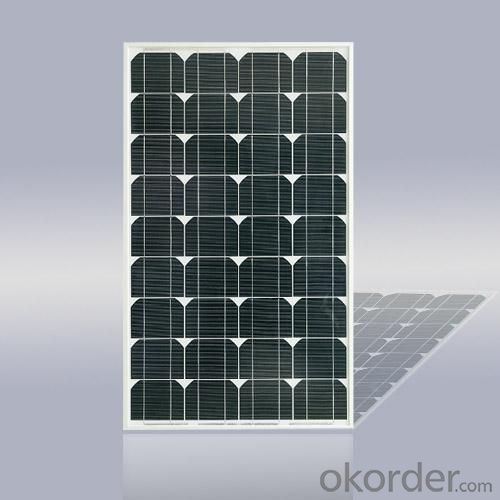
- Q: Can a solar inverter be used for off-grid systems?
- Yes, a solar inverter can be used for off-grid systems. Off-grid systems are not connected to the utility grid and rely solely on renewable energy sources like solar panels. A solar inverter converts the direct current (DC) generated by the solar panels into alternating current (AC) which can be used to power appliances and devices in an off-grid system.
- Q: Are there any safety concerns with solar inverters?
- Yes, there can be safety concerns with solar inverters. Some potential issues include electrical shocks from improper installation or maintenance, fire hazards due to faulty wiring or overheating, and electromagnetic radiation. However, these risks can be minimized through proper installation, regular inspections, and adherence to safety guidelines and regulations.
- Q: What are the installation requirements for a solar inverter?
- The installation requirements for a solar inverter typically include a suitable mounting location, adequate ventilation, and a compatible electrical system. It should be installed in an area with good sunlight exposure and away from any shading or obstructions. The inverter should be mounted securely on a sturdy surface, preferably indoors or in a weatherproof enclosure. Proper grounding and electrical connections are also necessary to ensure safe and efficient operation. It is essential to follow the manufacturer's guidelines and local electrical codes during installation.
- Q: How does a solar inverter affect the overall aesthetics of a solar installation?
- A solar inverter does not have a direct impact on the overall aesthetics of a solar installation as it is typically installed indoors or in a separate enclosure. The inverter's primary function is to convert the DC electricity generated by the solar panels into usable AC electricity for consumption. However, it is important to choose an inverter that is compatible with the installation's design and size to ensure efficient operation and minimal visual impact.
- Q: What is the role of power factor correction in a solar inverter?
- The role of power factor correction in a solar inverter is to improve the efficiency and performance of the inverter by correcting and optimizing the power factor of the electrical system. By adjusting the phase relationship between voltage and current, power factor correction ensures that the inverter draws and supplies power more effectively, reducing energy losses, improving power quality, and minimizing harmonics in the system. This helps to maximize the overall power output and reliability of the solar inverter, leading to better energy conversion and utilization.
- Q: Does a solar inverter require any additional cooling or ventilation?
- Yes, a solar inverter typically requires additional cooling or ventilation. This is because the inverter converts the direct current (DC) generated by solar panels into alternating current (AC) that can be used to power household appliances. During this conversion process, the inverter generates heat, and to maintain optimal performance and prevent overheating, it requires proper cooling or ventilation mechanisms.
- Q: Can a solar inverter be used with solar-powered outdoor lighting?
- Yes, a solar inverter can be used with solar-powered outdoor lighting. A solar inverter is responsible for converting the DC (direct current) electricity produced by solar panels into AC (alternating current) electricity that can be used to power various devices, including outdoor lighting systems. This allows the solar-powered outdoor lighting to function efficiently and effectively.
- Q: What are the safety features in a solar inverter?
- Playing a crucial role in the conversion of direct current (DC) electricity from solar panels to alternating current (AC) electricity, solar inverters, also known as photovoltaic (PV) inverters, are equipped with various safety features to ensure their safe and efficient operation. Among the primary safety features of a solar inverter is ground fault protection. This feature is designed to detect any leakage of current to the ground, which may indicate a fault in the system. If a ground fault is detected, the inverter will immediately shut down to prevent potential electrocution hazards. To safeguard against overvoltage situations, solar inverters are equipped with surge protection devices (SPDs). These devices divert excessive voltage spikes or surges to the earth, thereby protecting the inverter and other connected electrical equipment from damage. In the event of a grid power outage or blackout, solar inverters have anti-islanding protection. This feature ensures that the inverter automatically disconnects from the grid, preventing power backfeeding, which could pose a serious threat to utility workers attempting to repair the grid. Temperature monitoring is another crucial safety feature in solar inverters. With the potential for heat generation during operation, inverters are equipped with temperature sensors to monitor internal temperature. If the temperature exceeds the safe limit, the inverter will automatically shut down to prevent potential fire hazards. Additionally, solar inverters often incorporate built-in arc fault circuit interrupters (AFCIs). These devices are designed to detect and interrupt dangerous arc faults that may occur due to damaged or deteriorating wiring connections. By promptly stopping the flow of electricity, AFCIs help prevent electrical fires. Lastly, many solar inverters feature advanced monitoring and diagnostic systems. These systems provide real-time data and alerts, enabling users or installers to promptly identify and address potential safety issues. In conclusion, the safety features in a solar inverter are essential for ensuring the secure and reliable operation of the system. These features protect against electrical hazards, prevent damage to the inverter and connected equipment, and contribute to the overall safety of the solar power generation system.
- Q: What is the maximum output voltage of a solar inverter?
- The maximum output voltage of a solar inverter depends on various factors such as the inverter model, design, and specifications. However, in general, the maximum output voltage of a solar inverter is typically around 230-240 volts for residential or commercial applications.
- Q: Can a solar inverter be used in areas with unstable grid power?
- Yes, a solar inverter can be used in areas with unstable grid power. In fact, solar inverters are often used in such areas to provide a stable and reliable power supply. The inverter's ability to convert solar energy into usable electricity allows it to function independently of the grid power, ensuring a continuous power supply even during grid outages or fluctuations.
Send your message to us
Solar Inverter Battery String Solar Power Inverter 10KW-20KW-US, ETL
- Loading Port:
- Shekou
- Payment Terms:
- TT OR LC
- Min Order Qty:
- 5 watt
- Supply Capability:
- 10000 watt/month
OKorder Service Pledge
OKorder Financial Service
Similar products
Hot products
Hot Searches
Related keywords
